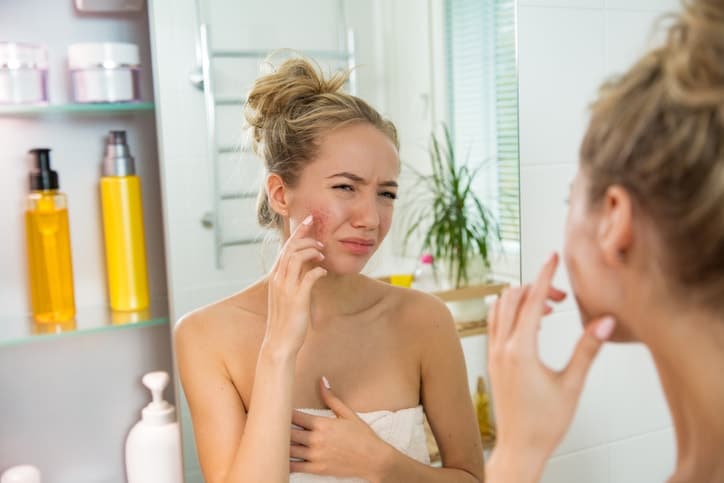Do I Have Rosacea?

Rosacea (pronounced “roh-ZAY-sha”) is a common skin condition, which can also affect your eyes. It is a chronic but treatable condition that mainly affects the center of your face. It’s a condition that comes in cycles - it often flares up and then goes away.
Rosacea Symptoms
Symptoms usually start after a person turns 30 years old. Rosacea presents with flushing or redness on the cheeks, nose, chin, or forehead that comes and goes.
Other symptoms can include:
- Visible blood vessels
- Inflammatory bumps
- Pimples
- Swollen or bumpy nose due to excess tissue
- Irritated, watery or bloodshot eyes
Different Types of Rosacea
Rosacea doesn’t always look like a red, flushed face. When you know the different ways it can appear, it can help you understand the different forms, so you can determine if you may have it. The four major types are:
- Erythematotelangiectatic rosacea: One of the most common types, the erythematotelangiectatic form appears as a red facial flushing (called erythema) accompanied by noticeable blue or red blood vessels.
- Papulopustular rosacea: With this type, you’ll see bumps on the skin that look like acne, but aren’t caused by the same bacteria that causes acne. Noticeable blood vessels and flushing may also appear.
- Phymatous rosacea: This subtype is characterized by thick, red skin typically seen on the nose.
- Ocular rosacea: This can also affect your eyes. Your eyes may burn, sting, look bloodshot, or feel gritty. Some people with this type of rosacea report blurry vision, sensitivity to light, tearing, or dry eyes.
What are Common Treatments for Rosacea?
Treatments for rosacea can prevent it from worsening, help you feel more comfortable, boost your self-confidence, and improve your quality of life. The specific treatments your dermatologist recommends will depend on your particular circumstances and may include:
- Oral and topical medications may be used to treat the various signs and symptoms you have. Redness, bumps, and pimples are often treated with oral and topical medications to quickly bring symptoms under control. Then, long-term use of anti-inflammatory therapies are used to maintain remission or to treat ocular rosacea.
- Lasers, which are intense pulses of light, are used to remove visible blood vessels or fix the redness and/or thickness of the nose.
What Can You Expect if You’re Diagnosed with Rosacea?
Your long-term medical therapy will help control symptoms. You can also improve your chances of staying in remission by identifying and avoiding environmental and lifestyle factors that can cause flare-ups or worsen your condition. You’ll have to identify these factors for yourself because what causes a flare-up in one individual may have no effect on another. Identify your personal trigger factors by keeping a diary of daily activities or events and relating them to any flare-ups you experience.
Check with your dermatologist to see if your skin care routine is compatible with your rosacea. A skin care routine that is gentle on your skin can help to control your skin condition. Cleanse your face using a mild, non-abrasive cleanser. Rinse well with lukewarm (not hot) water, and pat your face dry with a soft cotton towel. Avoid pulling or tugging your skin, and don’t use rough washcloths.
Do You Suspect You May Have Rosacea?
If you are living with symptoms of a skin condition, visit Keys Dermatology. Our doctors are experienced, board-certified skin doctor serving the Florida Keys for more than two decades. Keys Dermatology provides a full range of dermatology procedures to treat a wide variety of skin problems. Visit our friendly office today, or schedule a consultation by calling 305.664.8828 or filling out the form right on this page.
